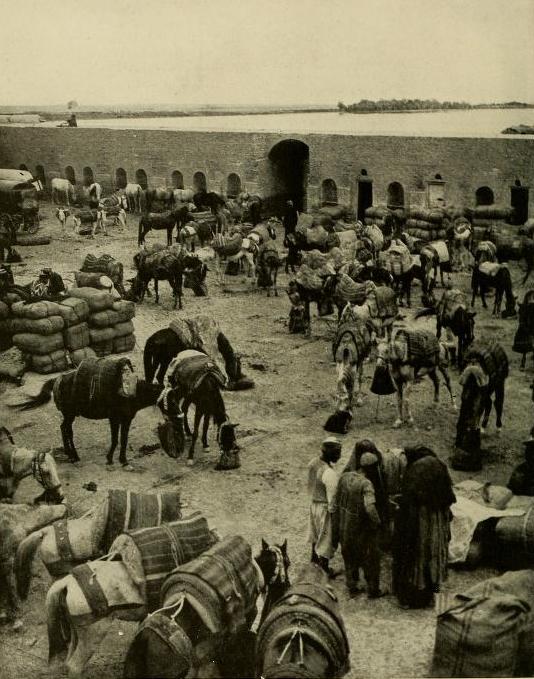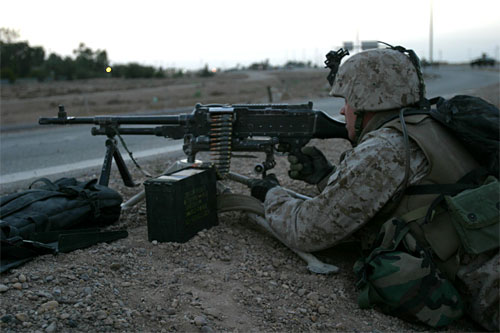|
Martyrs' Cemetery
The Martyrs' Cemetery of Fallujah is the chief burial site of Iraqis killed during the First Battle of Fallujah, both insurgents and civilians. It was formerly the football field of the Falluja Sports Club, and was converted into a cemetery after US troops blockaded attempts to reach the city's main cemetery. A sign outside the cemetery reads "''This cemetery is given by the people of Fallujah to the heroic martyrs of the battle against the Americans, and to the martyrs of the Jihadi operations against the Americans, assigned and approved by the Mujahideen Shura Council in Fallujah.''" The cemetery holds between 250 and 500 bodies, only one of which is identified as a foreign fighter, a Tunisian. At least 22 of the dead were from a single US mortar-attack in June 2004. The road leading to the cemetery has been named Martyrs' Cemetery Road, and according to the '' Mafkarat al-Islam'' was the site of an August 26 2006 attack against a US convoy on the road headed to the ... [...More Info...] [...Related Items...] OR: [Wikipedia] [Google] [Baidu] |
Fallujah
Fallujah ( ar, ٱلْفَلُّوجَة, al-Fallūjah, Iraqi pronunciation: ) is a city in the Iraqi province of Al Anbar, located roughly west of Baghdad on the Euphrates. Fallujah dates from Babylonian times and was host to important Jewish academies for many centuries. The city grew from a small town in 1947 to having a population of 275,128 inhabitants in 2011. Within Iraq, it is known as the "city of mosques" for the more than 200 mosques found in the city and the surrounding villages. The city became a major center of resistance against the Iraqi government during the Iraqi insurgency and the city was the scene of fierce fighting during the First and Second Battles of Fallujah. These battles left much of the city heavily damaged. In January 2014, the city was captured by the Islamic State and suffered major population loss. On 23 May 2016, Iraqi forces announced the beginning of their attempt to retake Fallujah from IS. On 26 June 2016 the city was declared fully ... [...More Info...] [...Related Items...] OR: [Wikipedia] [Google] [Baidu] |
Iraq
Iraq,; ku, عێراق, translit=Êraq officially the Republic of Iraq, '; ku, کۆماری عێراق, translit=Komarî Êraq is a country in Western Asia. It is bordered by Turkey to the north, Iran to the east, the Persian Gulf and Kuwait to the southeast, Saudi Arabia to the south, Jordan to the southwest and Syria to the west. The capital and largest city is Baghdad. Iraq is home to diverse ethnic groups including Iraqi Arabs, Kurds, Turkmens, Assyrians, Armenians, Yazidis, Mandaeans, Persians and Shabakis with similarly diverse geography and wildlife. The vast majority of the country's 44 million residents are Muslims – the notable other faiths are Christianity, Yazidism, Mandaeism, Yarsanism and Zoroastrianism. The official languages of Iraq are Arabic and Kurdish; others also recognised in specific regions are Neo-Aramaic, Turkish and Armenian. Starting as early as the 6th millennium BC, the fertile alluvial plains between Iraq's Tigris and Euphrates ... [...More Info...] [...Related Items...] OR: [Wikipedia] [Google] [Baidu] |
Demographics Of Tunisia
Tunisia's population was estimated to be around 12.04 million in 2022. In the generally youthful African continent, Tunisia's population is among the most mature. This is because the government has supported a successful family planning program that has reduced the population growth rate to just over 1% per annum, contributing to Tunisia's economic and social stability. The population of Tunisia is made up of Arabs (98%), Berbers (1%), and others (1%). Around 98 percent of the population are Muslim. There is a Jewish population on the southern island of Djerba and in Tunis. There also exists a small autochthonous group of Christian adherents.International Religious Freedom Report 2007: Tunisia United States [...More Info...] [...Related Items...] OR: [Wikipedia] [Google] [Baidu] |
Iraq War
{{Infobox military conflict , conflict = Iraq War {{Nobold, {{lang, ar, حرب العراق (Arabic) {{Nobold, {{lang, ku, شەڕی عێراق ( Kurdish) , partof = the Iraq conflict and the War on terror , image = Iraq War montage.png , image_size = 300px , caption = Clockwise from top: US troops at Uday and Qusay Hussein's hideout; insurgents in northern Iraq; the toppling of the Saddam Hussein statue in Firdos Square , date = {{ubl, {{Start and end dates, 2003, 3, 20, 2011, 12, 18, df=yes({{Age in years, months and days, 2003, 03, 19, 2011, 12, 18) , place = Iraq , result = * Invasion and occupation of Iraq * Overthrow of Ba'ath Party government * Execution of Saddam Hussein in 2006 * Recognition of the Kurdistan Autonomous Region * Emergence of significant insurgency, rise and fall of al-Qaeda in Iraq * January 2005 Iraqi parliamentary election and formation of Shia-led gov ... [...More Info...] [...Related Items...] OR: [Wikipedia] [Google] [Baidu] |
First Battle Of Fallujah
The First Battle of Fallujah, code-named Operation Vigilant Resolve, was an operation against militants in Fallujah as well as an attempt to apprehend or kill the perpetrators of the killing of four U.S. contractors in March 2004. The chief catalyst for the operation was the highly publicized killing and mutilation of four Blackwater USA private military contractors,Operation Vigilant Resolve, GlobalSecurity.org. and the killings of five American soldiers in Habbaniyah a few days earlier. The battle polarized public opinion within Iraq. Background Fallujah had generally benefited economically under Saddam Hussein, and many residents were employed as military and intelligence officers by his administration. However, there was little sympathy for him following the collapse of his government, which many residents considered oppressive. The city was one of the most religious and culturally traditional areas in Iraq. Following the collapse of the Ba'ath infrastructure in early ... [...More Info...] [...Related Items...] OR: [Wikipedia] [Google] [Baidu] |
Association Football Pitch
A football pitch (also known as soccer field) is the playing surface for the game of association football. Its dimensions and markings are defined by Law 1 of the Laws of the Game, "The Field of Play". The pitch is typically made of natural turf or artificial turf, although amateur and recreational teams often play on dirt fields. Artificial surfaces are allowed only to be green in colour. All line markings on the pitch form part of the area which they define. For example, a ball on or above the touchline is still on the field of play, and a foul committed over the line bounding the penalty area results in a penalty. Therefore, a ball has to completely cross the touchline to be out of play, and a ball has to wholly cross the goal line (between the goal posts) in order for a goal to be scored; if any part of the ball is still on or above the line, a goal is not scored and the ball is still in play. The field descriptions that apply to adult matches are described below. Becau ... [...More Info...] [...Related Items...] OR: [Wikipedia] [Google] [Baidu] |
Jihad
Jihad (; ar, جهاد, jihād ) is an Arabic word which literally means "striving" or "struggling", especially with a praiseworthy aim. In an Islamic context, it can refer to almost any effort to make personal and social life conform with God's guidance, such as struggle against one's evil inclinations, proselytizing, or efforts toward the moral betterment of the Muslim community (''Ummah''), though it is most frequently associated with war. In classical Islamic law (''sharia''), the term refers to armed struggle against unbelievers, while modernist Islamic scholars generally equate military ''jihad'' with defensive warfare. In Sufi circles, spiritual and moral jihad has been traditionally emphasized under the name of ''greater jihad''. The term has gained additional attention in recent decades through its use by various insurgent Islamic extremist, militant Islamist, and terrorist individuals and organizations whose ideology is based on the Islamic notion of ''jihad ... [...More Info...] [...Related Items...] OR: [Wikipedia] [Google] [Baidu] |
Mujahideen Shura Council (Iraq)
The Mujahideen Shura Council (MSC) ( ar, مجلس شورى المجاهدين في العراق), was an umbrella organization of at least six Sunni Islamic insurgent groups taking part in the Iraqi insurgency against U.S. and coalition and Iraqi forces: Tanzim Qaidat al-Jihad fi Bilad al-Rafidayn ('al-Qaeda in Iraq'), ''Jaish al-Ta'ifa al-Mansurah'', ''Katbiyan Ansar Al-Tawhid wal Sunnah'', Saraya al-Jihad Group, al-Ghuraba Brigades, and al-Ahwal Brigades. Al-Qaeda in Iraq—part of the Mujahideen Shura Council—was in September 2006 believed by the United States to be "the most significant political force" in the Iraqi Al Anbar province. In mid-October 2006, a statement was released, stating that the Mujahideen Shura Council had been disbanded, and was replaced by the Islamic State of Iraq. Formation and names On 15 January 2006, in a statement posted to the jihadist website Hanin Net, 'al-Qaeda in Iraq' (AQI, ''Tanzim Qaidat al-Jihad fi Bilad al-Rafidayn'') spokesman Abu M ... [...More Info...] [...Related Items...] OR: [Wikipedia] [Google] [Baidu] |
Mortar (weapon)
A mortar is usually a simple, lightweight, man-portable, muzzle-loaded weapon, consisting of a smooth-bore (although some models use a rifled barrel) metal tube fixed to a base plate (to spread out the recoil) with a lightweight bipod mount and a sight. They launch explosive shells (technically called bombs) in high-arcing ballistic trajectories. Mortars are typically used as indirect fire weapons for close fire support with a variety of ammunition. History Mortars have been used for hundreds of years. The earliest mortars were used in Korea in a 1413 naval battle when Korean gunsmiths developed the ''wan'gu'' (gourd-shaped mortar) (완구, 碗口). The earliest version of the ''wan'gu'' dates back to 1407. Choi Hae-san (최해산, 崔海山) (1380–1443), the son of Choe Mu-seon (최무선, 崔茂宣) (1325–1395), is generally credited with inventing the ''wan'gu''. In the Ming dynasty, general Qi Jiguang recorded the use of a mini cannon called the Hu dun pao that ... [...More Info...] [...Related Items...] OR: [Wikipedia] [Google] [Baidu] |
Humvee
The High Mobility Multipurpose Wheeled Vehicle (HMMWV; colloquial: Humvee) is a family of light, four-wheel drive, military trucks and utility vehicles produced by AM General. It has largely supplanted the roles previously performed by the original jeep, and others such as the Vietnam War-era M151 jeep, the M561 "Gama Goat", their M718A1 and M792 ambulance versions, the Commercial Utility Cargo Vehicle, and other light trucks. Primarily used by the United States military, it is also used by numerous other countries and organizations and even in civilian adaptations. The Humvee saw widespread use in the Gulf War of 1991, where it navigated the treacherous desert terrain; this usage helped to inspire civilian Hummer versions. The vehicle's original unarmored design was later seen to be inadequate. The vehicle was found to be particularly vulnerable to improvised explosive devices in the Iraq War. The U.S. hastily up-armored select models and replaced front-line units wi ... [...More Info...] [...Related Items...] OR: [Wikipedia] [Google] [Baidu] |
Cemeteries In Iraq
A cemetery, burial ground, gravesite or graveyard is a place where the remains of dead people are buried or otherwise interred. The word ''cemetery'' (from Greek , "sleeping place") implies that the land is specifically designated as a burial ground and originally applied to the Roman catacombs. The term ''graveyard'' is often used interchangeably with cemetery, but a graveyard primarily refers to a burial ground within a churchyard. The intact or cremated remains of people may be interred in a grave, commonly referred to as burial, or in a tomb, an "above-ground grave" (resembling a sarcophagus), a mausoleum, columbarium, niche, or other edifice. In Western cultures, funeral ceremonies are often observed in cemeteries. These ceremonies or rites of passage differ according to cultural practices and religious beliefs. Modern cemeteries often include crematoria, and some grounds previously used for both, continue as crematoria as a principal use long after the interment ... [...More Info...] [...Related Items...] OR: [Wikipedia] [Google] [Baidu] |




